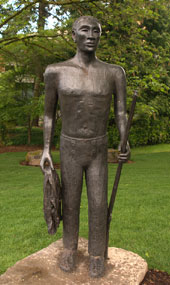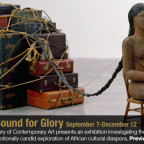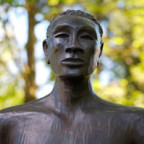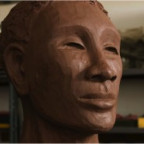Recognizing York
York: Terra Incognita—Lewis & Clark’s permanent memorial to York—honors a key member of the Corps of Discovery too long ignored by history.

This powerful sculpture by the world-renowned artist Alison Saar helps Lewis & Clark College remember an enslaved man who was part of the Lewis and Clark Expedition. A crucial contributor to the Corps of Discovery’s success, York shared in none of the fame and fortune enjoyed by other members of the corps after the journey concluded and was denied his freedom by his enslaver, William Clark.
The York memorial project began with Charles Neal JD ’07—at the time a student at Lewis & Clark Law School—and a question about the Black slave who was a vital member of the Lewis and Clark Expedition: where was York represented on the campus of the college that bears the famed explorers’ names? Neal rallied support for the project, and secured funding from lead donors Jacqueline Alexander JD ’07 and her husband Leodis Matthews JD ’73, along with unanimous financial support from the Board of Trustees and some additional funding from the institution.
Dedicated on May 8, 2010, at a prime location near Watzek Library, the York sculpture stands six feet tall and is mounted on an approximately two-foot-wide bronze base. Neither the physique nor the facial features of the sculpture claim to represent how York actually looked.
In her proposal to the York Committee, Saar wrote, “I have a personal interest in the recognition of unsung heroes, particularly those who have been overlooked due to their race or gender.” Several of her earlier sculptures have also addressed this theme. “Because there are no known images of York,” Saar explains, “I felt a realistic portrait would only continue to misrepresent the man.”
More information…
Partly for this reason, Saar made the sculpture’s back a focal point and a symbol of the burden borne by York during the Lewis and Clark Expedition. One of William Clark’s maps is inscribed—“scarred” might be more accurate—on the figure’s back and shoulders.
“The sculpture stands as a visual metaphor for a historic moment that we must regard more thoughtfully if we are to understand American history,” says Linda Tesner, York Committee chair and former director of the college’s Ronna and Eric Hoffman Gallery of Contemporary Art.
Links for additional information:
- York biography, PBS
- “Hasan Davis portrays York, Black Explorer,” Hasan Davis website
- “Searching for York,” Oregon Public Broadcasting
- “Interpretations of York’s Character and His Role in the Lewis and Clark Expedition,” Darrell M. Millner, Oregon Historical Quarterly
- “The Slave Who Went With Them,” Time magazine
-
“Q&A with York Memorial Project Chair Linda Tesner,” The Source
June 24, 2008 -
Dedication of York’s Statue, Remarks by Valerie Craigwell White, Lewis & Clark Ombudspersonr
May 8, 2010 - In 2021, Jess Perlitz, associate professor of art and head of sculpture, codirected the Portland Monuments and Memorials Project (PMMP). This project brought “people together to consider the conditions and impacts of public monuments in Portland, including those that have been removed and those that should be built.” The central question that was considered during the project was, “What is an appropriate monument or memorial for this time and place?” Professor Perlitz, along with Associate Professor of History Reiko Hillyer and artist Allison Saar, came together in conversation to discuss and reimagine historical narratives and possibilities and how they might be given form.
Related News
Top 10 news stories from Lewis & Clark in 2010
Multimedia: Saar exhibition at Hoffman Gallery explores race and gender
York Memorial commended by local media
The Oregonian’s review of Lewis & Clark’s York Memorial praises the work’s “subtle power” and the college’s leadership in challenging public memory.
Multimedia: York Memorial honors neglected historical figure
Main
503-768-7000
Visiting Us
Lewis & Clark
615 S. Palatine Hill Road
Portland OR 97219



